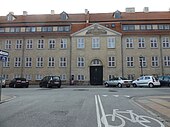
The Battle of Zealand Point was a naval battle of the English Wars and the Gunboat War. Ships of the Danish and British navies fought off Zealand Point on 22 March 1808; the battle was a British victory. Peter Willemoes was among the Danish casualties,

The Yellow Palace, or Bergum's Mansion, is an 18th-century town mansion situated at Amaliegade 18, next to Amalienborg Palace, in the Frederiksstaden district of Copenhagen, Denmark. It is considered the first example of Neoclassical architecture in Copenhagen.

Højbro Plads is a rectangular public square located between the adjoining Amagertorv and Slotsholmen Canal in the City Centre of Copenhagen, Denmark. It takes its name from the Højbro Bridge which connects it to the Slotsholmen island on the other side of the canal while Gammel Strand extends along the near side of the canal.

Kronprinsessegade is a street in central Copenhagen, Denmark. Noted for its fine Neoclassical houses, it extends from Gothersgade and runs along the southern boundary of Rosenborg Castle Garden, passing Sølvgade and the Nyboder district of old naval barracks before finally joining Øster Voldgade close to Østerport Station. The David Collection, a museum which displays a large collection of Islamic art as well as Danish and European fine and applied arts, is based at No. 30.

Brøste House, also known as Potter House after its founder, Thomas Potter, a Scottish born industrialist, is a late 18th-century historic property at Overgaden Oven Vandet 10, overlooking Christianshavn Canal, in the Christianshavn neighbourhood of Copenhagen, Denmark. The building was listed in the Danish registry of protected buildings and places in 1918. It is now owned by Barfoed Group.
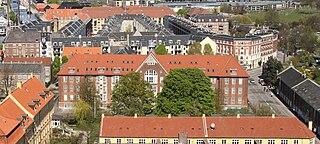
Christianshavn School is a public primary school in the Christianshavn district of Copenhagen, Denmark. The building is a former naval hospital.

Ryesgade is a street straddling the border of the Nørrebro and Østerbro districts of Copenhagen, Denmark. Together with Ravnsborggade, its continuation to the south, it forms the backbone of a small neighbourhood bounded by The Lakes to the east, Blegdamsvej to the west, Nørrebrogade to the south and Østerbrogade to the north. The busy artery Fredensgade and the adjacent Fredens Park, effectively separates the Nørrebro and Østerbro portions of Ryesgade from each other. Ryesgade was formerly known for its many second-hand stores of which a few still exist today.

Krystalgade is a street in central Copenhagen, Denmark, connecting Nørregade to Købmagergade. Copenhagen Central Library and the Great Synagogue of Copenhagen are located in the street.

Åboulevard is a street in central Copenhagen, Denmark. Together with H. C. Andersens Boulevard in the city centre and Borups Allé, it forms a major artery in and out of the city. The road is built over Ladegårds Å, a canal originally built to supply Copenhagen with water, which still runs in a pipe under it, feeding water into Peblinge Lake.

Næstved Museum is located in Helligåndshuset in Næstved, central Zealand, Denmark. Its collections trace the development of the area from the last ice age to the present. Highlights include an extensive collection of textiles and exhibitions of artefacts from the Kähler Ceramics Factory and from the Holmegaard Glass Factory.

Slotsholmsgade is a street which runs along the rear side of Børsen on Slotsholmen in central Copenhagen, Denmark. Located next to the Danish parliament building Christiansborg, most of the buildings in the street house government offices. Several of them date from the 17th and 18th century and are listed.
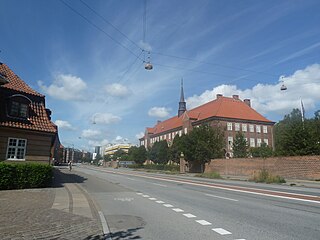
Tagensvej is a major street in the northwestern part of inner Copenhagen, Denmark. It runs from Blegdamsvej on the border between Nørrebro and Østerbro in the southeast to Frederiksborgvej and Bispebjerg Cemetery in the northwest.

Usserød Textile Factory is a listed, 19th-century industrial complex at Usserød Å in the Usserød district of Hørsholm, Denmark. It was from 1802 home to the Royal Military Textile Factory which remained in use until 1981. The buildings have now been renovated and are now used as a business park.

Rigensgade is a street in central Copenhagen, Denmark. It links Sølvgade in the west with Øster Voldgade in the east. An underpass for pedestrians link the beginning of the street with Rosenborg Castle Gardens on the other side of Sølvgade. Notable buildings include the former Garrison Hospital. and the Methodist Jerusalem's Church.
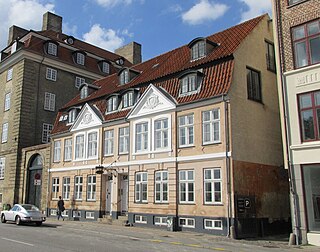
The Holmblad House, now also known as Sølvgården, is a former 18th-century dyeing facility at Sølvgade 38 in Copenhagen, Denmark. Its founder, Jacob Holmblad, also had his home in the complex. The building was listed by the Danish Heritage Agency in the Danish national registry of protected buildings in 1918.

Niels Hemmingsens Gade is a street in the Old Town of Copenhagen, Denmark. It runs from the western part of Amagertorv in the south to Skindergade in the north and passes Gråbrødretorv on the way. The Church of the Holy Ghost is located in the street. The street is named after the 16th-century Lutheran theologian Niels Hemmingsen.

Jægersborg Barracks, also known as Jægergården, is a former military facility located on Jægersborg Allé in Gentofte in the northern suburbs of Copenhagen, Denmark. It was converted into housing in 2010.
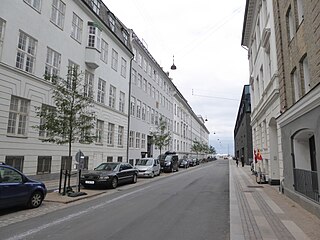
Kvæsthusgade is a short street in the Nyhavn Quarter of central Copenhagen, Denmark. It runs from the mouth of the Nyhavn canal in the south to Ofelia Plads in the north. The rear side of the Royal Danish Playhouse dominates the east side of the street.
Bernhard Seidelin (1820–1863) was a Danish architect. His most notable works include Helsingør station and Nyboder Girls' School.
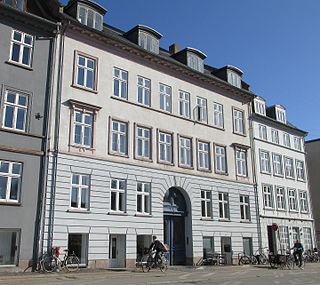
Sølvgade 20–22 are two Neoclassical apartment buildings situated opposite Rosenborg Castle Garden in central Copenhagen, Denmark, constructed by master builder Thomas Blom between 1826 and 1831. They were individually listed in the Danish registry of protected buildings and places in 1977. Notable former residents of Sølvgade 20 include the military officer J.H. Mansa (1797-1885), politician Niels Møller Spandet, naval officer Carl van Dockum, army officer Olaf Rye, archaeologist Jens Jacob Asmussen Worsaae, journalist Gustav Esmann, historian and politician Niels Neergaard and actress Karen Lykkehus. Notable former residents of Sølcgade 22 include the military officer Carl Julius Flensborg.


